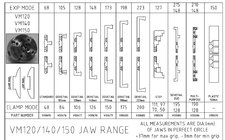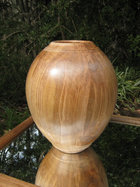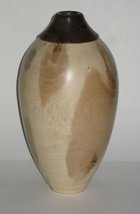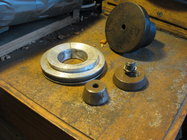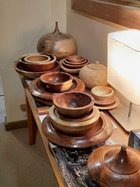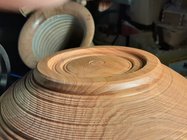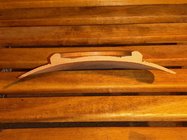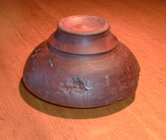I have much less experience than most of you but agree that, except for end-grain pieces (especially hollow forms), either work just as well if formed correctly. The only other limitation on recesses would be for very small pieces as there would likely not be enough area to provide a wide enough shoulder for the recess to prevent failure. I know that because I used to use a recess on all my pieces, but had failures when the piece was small enough due to lack of adequate shoulders. For those pieces (don't turn many small pieces anymore), I use a tenon and the appropriate smaller jaws. Really, the method that works best for each turner is the best. We all have ways of doing things which others would find uncomfortable or which do not fit with their way of doing things.I have a video up on You Tube about mounting things on the lathe. The debate continues about which holds better, a tenon or a recess. My response is that both hold equally well as long as they are made properly. Tenon has to be sized for the bowl you are turning. The shoulder on the recess also has to be sized to the bowl you are turning. In both situations, if they are too small for the bowl you are turning, you will get a failure.
As for the argument about 'the bottom is not finished because you can see how the piece was mounted on the lathe', that appears to be some thing that woodturners say, but not one single customer ever commented on. There is no real mystery in how things are mounted on the lathe, tenon, recess, glue block. I don't think any one uses the face plate and then cover the screw holes with felt any more.
robo hippy
-
December 2025 Turning Challenge: Single Tree! (click here for details) -
Congratulations to Bob Henrickson, People's Choice in the November 2025 Turning Challenge (click here for details) -
Congratulations to John Dillon for "Chinquapin Oak" being selected as Turning of the Week for December 22, 2025 (click here for details) -
Welcome new registering member. Your username must be your real First and Last name (for example: John Doe). "Screen names" and "handles" are not allowed and your registration will be deleted if you don't use your real name. Also, do not use all caps nor all lower case.
You are using an out of date browser. It may not display this or other websites correctly.
You should upgrade or use an alternative browser.
You should upgrade or use an alternative browser.
Shoulder width on a bowl tenon
- Thread starter Rip Littig
- Start date
- Joined
- Apr 27, 2004
- Messages
- 9,307
- Likes
- 6,078
- Location
- Lakeland, Florida
- Website
- www.hockenberywoodturning.com
for the argument about 'the bottom is not finished because you can see how the piece was mounted on the lathe', that appears to be some thing that woodturners say,
From my perspective it is a design and process issue more than a customer issue.
If a hole in the bottom of the chuck size fits the deign then a recess can work for me.
I find the tenon compatible with the many designs that don’t have a hole in the bottom.
For twice turned bowls a tenons are much easier for me to true to do the second turning.
My first chuck only did recesses. So only did recesses.
I now rarely use a recess finding tenons much more compatible with my designs and processes.
Also if turning NE bowls a tenon wastes much less wood.
I don’t understand why using a recess prevents me the bottom from being “finished”. I have just turned off the excess material around the recess and the bottom is flat (or slightly concave). Given that there has to be w ouch wood to make a solid bottom in the recess nothing prevents the removal of the wood surrounding the recess.
The unmentioned advantage of the recess is that it will shrink in diameter and can often be trued up to the ideal diameter for the finish turning.For twice turned bowls a tenons are much easier for me to true to do the second turning
The tenon will also shrink but if you are using a dove tail tenon it is unlikely that the ideal diameter can be achieved, however if you are using the OneWay profile jaws then it would only be a problem if the initial tenon was close to the minimum diameter required.
Last edited:
- Joined
- Apr 27, 2004
- Messages
- 9,307
- Likes
- 6,078
- Location
- Lakeland, Florida
- Website
- www.hockenberywoodturning.com
The tenon will also shrink but if you are using a dove tail tenon it is unlikely that the ideal diameter can be achieved,
What works for me when using 48mm perfect circle Vicmarc dovetail jaws is to rough using a tenon about 64mm in diameter -2.5”
I turn the tenon 1” (I have trained myself to eyeball an inch quit well) from my ONEWAY Live center which is 5/8” diameter.
So the rough bowl tenon 2 5/8 +- This size tenon has always dried with a 48mm tenon inside
Plus the larger tenon is better for roughing.
2.5 is bigger than the perfect circle but the Vicmarc grips it perfectly well for turning and centering.
Perfect circle does give the best grip but a larger tenon is gripped more than well enough.
About the only times I go for a perfect circle is when I grip in what will be a finished groove. It leaves no visible mark
Al, when referring to 48 mm perfect circle jaws, I take it that you are thinking of the standard jaws for the Vic120?
- Joined
- Apr 27, 2004
- Messages
- 9,307
- Likes
- 6,078
- Location
- Lakeland, Florida
- Website
- www.hockenberywoodturning.com
I assume that everyone understood that I missed a few words, it should have read "achieved for the finish turning".The tenon will also shrink but if you are using a dove tail tenon it is unlikely that the ideal diameter can be achieved,
As for the argument about 'the bottom is not finished because you can see how the piece was mounted on the lathe', that appears to be some thing that woodturners say, but not one single customer ever commented on. There is no real mystery in how things are mounted on the lathe, tenon, recess, glue block. I don't think any one uses the face plate and then cover the screw holes with felt any more.
I'm with you on this RH. I remember the early foot wars, which really annoyed me at the time. I subscribed for many years to the NZ publication called 'Faceplate' (right back to their first issue in 1987) and they were very keen about disguising how the piece was held on the lathe, seemingly in an attempt to elevate the craft above the utilitarian.
Having spent some of my career in the world of ceramics in which how the foot was made was a significant feature of the piece and a point of judgement on how well the piece was made. One of the first things a master potter would do when assessing a piece is pick it up and turn it over to reveal the true craftsmanship in the foot, which is usually not masked by the glaze.
I've always been bemused by the woodturning fraternity's obsession with obliterating how a piece was held on the lathe while every national and state gallery has ceramic collections with feet that would be shunned by those woodturners, yet never a turned wooden bowl is to be found in any of those public galleries!
When the new owner took over the gallery where I sell my work some years ago he turned one of my pieces over (he had been a potter) and immediately said, "what a relief to find a descent foot on a wooden bowl". And, yes, all of my pieces retain the recess where were they were held for the final turning, including endgrain pieces...
My 2 cents on the recess thing. I’m enjoying this thread immensely!
That, no customers have complained about recesses, is hardly a ringing endorsemen.
There is no, or not to my knowledge, historical precedent for recesses on bowls. Ceramics, glass, hand carved, or baskets.
They effect the design of one’s piece. Allowance has to make regarding the thickness at the center of your bowl, so you loose that ‘spoon feel’, going from one rim to the other side smoothly, without changes and bumps or flat spots. Tough to do without making it paper thin at the recess.
It serves no purpose, other than being a left-over, a tell, from your methodology. Like a belly button. Had a purpose for a short time, now a left-over. In the case of the b.b. there are no options.
In our case, however, there is. So I respectfully suggest that you are giving, and leaving the attachment, unnecessarily.
A foot fixes the issue, as does a smooth round bottom. So, why not do one of those?
I strive to make each of my pieces, mine alone, as much as possible. So, I start with green logs and work from there. I consider everything, every cut, every curve, thickness here and there, from complex to simple decisions. A zillion decisions and ponderings, which make our art so fabulous. I’m just not willing to do all that, to call it my own if I’ve bailed at this critical part of our expression. I’m a great bowl turner, but I don’t do feet?
Do judges even comment about recesses? Like, ‘what a clever recess. Can you share the story of how you came to that?’
I doubt it, because it’s a non part of the piece.
That, no customers have complained about recesses, is hardly a ringing endorsemen.
There is no, or not to my knowledge, historical precedent for recesses on bowls. Ceramics, glass, hand carved, or baskets.
They effect the design of one’s piece. Allowance has to make regarding the thickness at the center of your bowl, so you loose that ‘spoon feel’, going from one rim to the other side smoothly, without changes and bumps or flat spots. Tough to do without making it paper thin at the recess.
It serves no purpose, other than being a left-over, a tell, from your methodology. Like a belly button. Had a purpose for a short time, now a left-over. In the case of the b.b. there are no options.
In our case, however, there is. So I respectfully suggest that you are giving, and leaving the attachment, unnecessarily.
A foot fixes the issue, as does a smooth round bottom. So, why not do one of those?
I strive to make each of my pieces, mine alone, as much as possible. So, I start with green logs and work from there. I consider everything, every cut, every curve, thickness here and there, from complex to simple decisions. A zillion decisions and ponderings, which make our art so fabulous. I’m just not willing to do all that, to call it my own if I’ve bailed at this critical part of our expression. I’m a great bowl turner, but I don’t do feet?
Do judges even comment about recesses? Like, ‘what a clever recess. Can you share the story of how you came to that?’
I doubt it, because it’s a non part of the piece.
- Joined
- Apr 27, 2004
- Messages
- 9,307
- Likes
- 6,078
- Location
- Lakeland, Florida
- Website
- www.hockenberywoodturning.com
You certainly can turn the ring away. So much easier to turn a tenon away.I don’t understand why using a recess prevents me the bottom from being “finished”. I have just turned off the excess material around the recess.
Tenon will have less complications from moving green wood
The tenon is less likely to be part of the curve.
Tenon has one edge to blend in. The ring has 2 or 3 edges to blend in.
I use faceplates on most of my face grain hollow forms. While the area where the faceplate mounts looks like a tenon it is more the size of a faceplate ring. Takes a lot of time to blend this area into the curve.
Often the wood will move making turning the surface to completion impossible. There will be a tiny step on one side and a perfectly turned curve on the other side that has to be blended in by sanding.
The average turner will struggle turning away a ring and may never get it looking good.
Not trying to be argumentative… but I have found no difference in turning away a tenon versus turning away a recess. Seems to me it’s just as easy to turn the outer ring off. I currently use tenons almost all the time but spent the first 3+ years when I learned turning using a recess. It was easier to cut the recess in using a Nova dovetail chisel. While I initially left the recess ring on I started turning it off and really it isn’t that tough. For larger bowls and hollow forms a tenon is likely stronger especially for end pieces but I’m not really sure. Anyway many of my turnings are not green so any green wood issues don’t come into play. Sorry to disagree, especially with someone more experienced than I am but i just don’t feel it really matters which you use.
- Joined
- Apr 27, 2004
- Messages
- 9,307
- Likes
- 6,078
- Location
- Lakeland, Florida
- Website
- www.hockenberywoodturning.com
Sorry to disagree, especially with someone more experienced than I am but i just don’t feel it really matters which you use.
It’s worth noting you see no difference. We all have different perspectives.
My first chuck only did recesses.
Not trying to be argumentative… but I have found no difference in turning away a tenon versus turning away a recess. Seems to me it’s just as easy to turn the outer ring off. I currently use tenons almost all the time but spent the first 3+ years when I learned turning using a recess. It was easier to cut the recess in using a Nova dovetail chisel. While I initially left the recess ring on I started turning it off and really it isn’t that tough. For larger bowls and hollow forms a tenon is likely stronger especially for end pieces but I’m not really sure. Anyway many of my turnings are not green so any green wood issues don’t come into play. Sorry to disagree, especially with someone more experienced than I am but i just don’t feel it really matters which you use.
Agreed, if you are going to turn off the tenon or recess there is no difference!
I'm not advocating either method for holding a piece while turning and finishing the inside, especially if you are then going to go back and subsequently remove the tenon or recess.
My contribution to this discussion is that a recess is a satisfactory option as both a holding technique and for aesthetic considerations. Not necessarily better than a tenon and, like most things, it has its pros and cons:
When final turning a piece, the first thing I do is form and finish the recess and never return to it. The foot is done! For me this is the biggest advantage for the recess holding method.
Aesthetic considerations as to the recess/foot size and shape have to be all made back at the green turning stage. This might be seen as a disadvantage until you are confident you can make all of the aesthetic decisions at the green turning stage.
If you are using a tenon that is going to be turned off then just a few chuck jaw sizes are required. But, to meet my aesthetic requirements for each piece I need a very wide range of chuck jaw sizes so that a limited number of available jaw sizes doesn't dictate the recess/foot size/shape. This has meant that I have had to acquire every available jaw size, plus a few custom made ones (from 1" right up to 9" ). This is a financial disadvantage with the way I use this method.
I also very occasionally lose a piece off the chuck when being held by the recess. It happens very rarely, but when it does the outside of the piece (which will be finished at that stage) will get a ding that requires it to be re-turned, sanded and polished again, if that is an option. I would call that a disadvantage if it weren't for the fact that I have seen Richard Raffan lose a piece off the chuck a number of times when holding a piece by its tenon. Richard has his particular method of holding a bowl that is finished on the outside, but held at that stage in tenon mode. He uses the Vicmarc step jaws that he designed for that, which is a cheaper option than my many jaws sets. So on the % of escapees from the jaws it is about even, but Richards step jaws are a plus on the cost side. The way pieces are held by those step jaws have some design limitations for me.
Randy, I also used some of the early recess holding jaws when they first came out. They were very welcome compared to the jam chucking that we had to use before those chuck innovations came along. Here is my old three-jawed expansion chuck, not that I have used that one in a very long time...
I used to use a recess all the time but after having a few bowls split in half I have gone to tenon 99 percent of the time.
We woodturners refer to a "fillet" as a flat often used as added detail in separating a a bead from a cove. Google defines a "fillet" using metal working terminology: "Fillets describe rounded corners of a design (or part) that help to reduce stresses"
It is my understanding that perhaps Stuart turns the shoulder of the tennon a bit smaller than the face of the chuck jaw, because NOVA jaws for example have a rounded edge (fillet). He wants the outside shoulder of the tennon to have solid location (stress) on the flat of the jaw not the rounded over edge.
It is my understanding that perhaps Stuart turns the shoulder of the tennon a bit smaller than the face of the chuck jaw, because NOVA jaws for example have a rounded edge (fillet). He wants the outside shoulder of the tennon to have solid location (stress) on the flat of the jaw not the rounded over edge.
Better explaining my theory....The tennon shoulder is cut concave so the outer most edge makes contact with the jaw face for maximum support. We want the shoulder a bit smaller than the jaw face so that the contact will be on the flat of the jaw where it is supported. If the tennon shoulder is cut larger than the face of the jaw then the contact point would be on the rounded outside edge of the jaw and would have potential to not be as supported from side to side forces while turning the bowl.
My 2 cents on the recess thing. I’m enjoying this thread immensely!
That, no customers have complained about recesses, is hardly a ringing endorsemen.
There is no, or not to my knowledge, historical precedent for recesses on bowls. Ceramics, glass, hand carved, or baskets.
They effect the design of one’s piece. Allowance has to make regarding the thickness at the center of your bowl, so you loose that ‘spoon feel’, going from one rim to the other side smoothly, without changes and bumps or flat spots. Tough to do without making it paper thin at the recess.
It serves no purpose, other than being a left-over, a tell, from your methodology. Like a belly button. Had a purpose for a short time, now a left-over. In the case of the b.b. there are no options.
In our case, however, there is. So I respectfully suggest that you are giving, and leaving the attachment, unnecessarily.
A foot fixes the issue, as does a smooth round bottom. So, why not do one of those?
I strive to make each of my pieces, mine alone, as much as possible. So, I start with green logs and work from there. I consider everything, every cut, every curve, thickness here and there, from complex to simple decisions. A zillion decisions and ponderings, which make our art so fabulous. I’m just not willing to do all that, to call it my own if I’ve bailed at this critical part of our expression. I’m a great bowl turner, but I don’t do feet?
Do judges even comment about recesses? Like, ‘what a clever recess. Can you share the story of how you came to that?’
I doubt it, because it’s a non part of the piece.
Marc
Apologies for the delayed response, but I’ve been mulling over your thoughtful posting...
Apologies also for the longer ramble following, some of it at a tangent and off topic to the OP, but I do get back to tenon/recess widths towards the end…
On customer endorsement...
Whatever we think about the aesthetic judgement of our customers, if they stop buying our pieces we will eventually have to stop making them. Not that their preferences should be the only determinant of what we make, but in the end they are the final arbiters. I always begin with a focus on each individual piece of wood I'm working with with little regard for where it might go after I'm aesthetically and craft-wise satisfied with the outcome. My practice is then to leave those pieces on display in various places about my house so that I can get a fresh look at them, at least until I can't accommodate any more. From those I then select the next batch to go to the gallery. Some of that decision is about what best goes with what...
The next arbiter might be the gallery owner/director deciding if my work meets their standard or style or market segment. I went through that selection process a very long time ago and nowadays they just accept whatever I take to them. Almost everything I take eventually sells and at a rate that is about comfortable for me to keep providing new work. Price is a factor in that, but not always. All of my higher priced pieces have sold, but occasionally there are some pieces that don't move in a reasonable time and they get removed from the display to keep it fresh. Some of those get recycled later back on display and sell and there are just a very few pieces (like the one in my avatar) that eventually get pulled from the gallery altogether and these become gifts for family and friends. In fairness to my fellow exhibitors I never discount my pieces and the gallery never bargains on price with customers.
So, for me, no matter what my aesthetic judgement may be about my work, it is the gallery clients who are the final arbiters of my pieces. By and large, they will not be as critical of my work as myself in terms of aesthetics and craft. Few, if any of them, will know or care about the nuances of form and finish, or for that matter feet, that we woodturners may anguish over. But, without their endorsement, which they do by purchasing our work, we don’t get to make more of what we think has merit.
~~~
On competition judges as arbiters of what is good in terms of aesthetics and craft...
I must admit I have no experience as either a judge or having my work formally judged since graduating art college over half a century ago. My grades back then were some indication that my aesthetic judgement was sound. I did also teach for a while in art and design at tertiary level, so was in effect making judgement on student work back then, but that was a long time ago. It may be different elsewhere, but Richard Raffan has said to me a number of times that the standard of woodturning here in Australia is quite low and, besides Richard himself, I would be hard put to find someone here whose judgement I would value. That is not to say that I don’t admire the work of others from around the world, which we can now see at least online nowadays. And, I like to keep learning from my own efforts and from others on forums like this one.
Local clubs and the like are another source of critique for their members. That is a good starting point if you have access to one of those at least in your early turning years. Their limitation is of course the limitation of its collective membership. For example, if you happened to be a member of the ACT Woodcraft Guild in Canberra, where Richard Raffan is a member, you would be very fortunate. But, the guidance in many other local clubs can be quite limited. Then there are clubs and associations that bring in the best turners from around the world for demo weekends and the like, and they can lift the level of turning among the participants, albeit with a bit of cloning that can follow.
For one reason and another, I haven’t had much exposure to such clubs and organisations, but I do have a circle of artist/artisan friends and colleagues and they readily express their opinions, free of charge, which is a form of judgement for what it is worth!
~~~
On there being... "no historical precedent for recesses on bowls. Ceramics, glass, hand carved, or baskets."
That misses the point I was trying to make, so my mistake, I probably wasn't clear enough in what I wrote. What I was attempting to say is that how an item was made isn't so obsessively disguised in other media as it seems to be in the case with woodturning. Leaving a recess in the foot of a woodturned piece is just an example of allowing the making process to remain in the finished piece. Here are three examples of allowing the making process to remain on the feet of some ceramic pieces in my collection...
None of that evidence of the making process on the foot of those pieces would be considered among the potters I know as a failure to complete the pieces. On the contrary, they are evidence of competent execution. Potters invariably turn over a piece to look for that evidence. I also always do the same with woodturned pieces that deserve closer attention. I’m looking to be delighted by what I find there. Far too often all I find there is a shallow featureless concave depression with the type of information inscribed there that is more suited to an entry in a catalogue that is more typical of an inscription on a souvenir. And, not the sort of thing you would expect to find on a piece of ceramics, cabinetry or glass in a national or state gallery collection. A maker's mark, yes, but not souvenir style information. No surprise that the fine art institutions don’t take woodturning seriously… :~}
~~~
Back to the recess itself…
For clarity, I do make a tenon when turning the outside of a green blank and use that to hold the piece when I’m green turning the inside, but then use a recess for the final seasoned turning of the inside of the piece.
For reference, here is the bottom of a piece with what I call a recess (mortice/mortise, if you prefer that term) that was on the lathe yesterday before reversing to return the inside. That is what I am referring to.
Several have commented to the effect that having/leaving a recess eliminates the option of having ‘a foot’. I presume what is meant there is that using and retaining a recess would restrict or prevent some feet options. I’m not sure where the notion comes from that using and retaining a recess would do that. Design wise I use whatever foot suits the piece and that is not limited in any way by using and retaining a recess during the final turning stage.
Likewise, I can’t think of any shape, inside or out, that is restricted by using a recess for the final turning. As the majority of the design decisions are made at the blank cutting and green turning stages, leaving the bottom of a bowl too thin by adding a recess is minimised. And, it seems to me that there is so little difference between what is left in the bottom of a piece between using a recess and dishing it when a tenon is turned off… it isn't a consideration.
Here is the remaining bottom of an experimental test piece that was laying around in the workshop that I have sawn in half to show the foot profile and recess. The top of that piece had previously been turned away during testing that I was doing for something, so the foot is no longer in proportion to the remaining walls, which are thinner than I would normally turn making the foot ring disproportionately larger than I would make it, but it servers the purpose of showing the recess that I use in making ‘the foot’ on bowls and other forms ...
Not much difference there between the depth of the recess and what would remain if dishing the bottom after removing the tenon.
My foot designs do require a deft hand when doing the final tuning out of the inside of pieces to avoid them splitting apart and/or letting go. As you would expect, they don't take too kindly to a catch, but fortunately they happen very rarely nowadays.
Getting back to OP’s original question, the width of the shoulder in the ‘recess’ has two functions; to ensure the piece is held securely in the chuck, but it is also a design element in the finished item. Getting the balance right between those two functions exercises both craft and aesthetic judgement.
For my part, I really can’t think of many of the pieces that I make that would be compromised in their design by my using a recess as the holding method for completing the insides of the piece. I don’t consider the recesses that I leave as unfinished business. I give them as much attention as any other design aspect of the piece as that is where my maker's mark goes, and as far as I know, nobody has referred to my recesses as ‘belly buttons’, but if they did, that’s OK too…
There are many satisfactory ways of going about things and I contend that using the recess on pieces the way I do is an effective and efficient technique with acceptable aesthetic outcomes. Perhaps not suited to every turner, but still a very satisfactory option for some of us.
That’s at least my 5c worth, so I will stop my rambling and leave it at that Marc, et al.
PS - I should add that RR has a good coverage on recess vs tenon holding starting on Pg36 of his book, Turning Wood with Richard Raffan, Taunton Press, 2001. You might be able to see an online version of that here... scroll down to Pg36.
As you can see, he is not an advocate of how I use the recesses, so thought I should provide a pointer to that authoritative point of view as your preferred holding method may align more closely to his.
I did try Richard's preferred method of pincing in on a tiny mortice groove in the tenon years ago, but didn't fall in love with it myself, so continued with what I was comfortable with. Other than on the rare occasion, I have never had the difficulties with narrow foot rings splitting at the end grain point when held by the recess, the way Richard explains, and certainly no more than I've seen pieces escaping out of Richard's multi-jaws. Your
Offsetting the jaws by 45deg from the grain direction reduces the chance of the foot ring splitting. And, of course, a full-on catch will defeat almost any holding method, so a good technique is essential...
Here is the bottom of a piece on which I used something like Richard's preferred method... done about the time that the first self centering scroll chucks for woodturners became available from Teknatool in the mid-80s, back when I was first experimenting with those, but I've not used that holding method since.
As you can see, he is not an advocate of how I use the recesses, so thought I should provide a pointer to that authoritative point of view as your preferred holding method may align more closely to his.
I did try Richard's preferred method of pincing in on a tiny mortice groove in the tenon years ago, but didn't fall in love with it myself, so continued with what I was comfortable with. Other than on the rare occasion, I have never had the difficulties with narrow foot rings splitting at the end grain point when held by the recess, the way Richard explains, and certainly no more than I've seen pieces escaping out of Richard's multi-jaws. Your
Offsetting the jaws by 45deg from the grain direction reduces the chance of the foot ring splitting. And, of course, a full-on catch will defeat almost any holding method, so a good technique is essential...
Here is the bottom of a piece on which I used something like Richard's preferred method... done about the time that the first self centering scroll chucks for woodturners became available from Teknatool in the mid-80s, back when I was first experimenting with those, but I've not used that holding method since.
Last edited:

